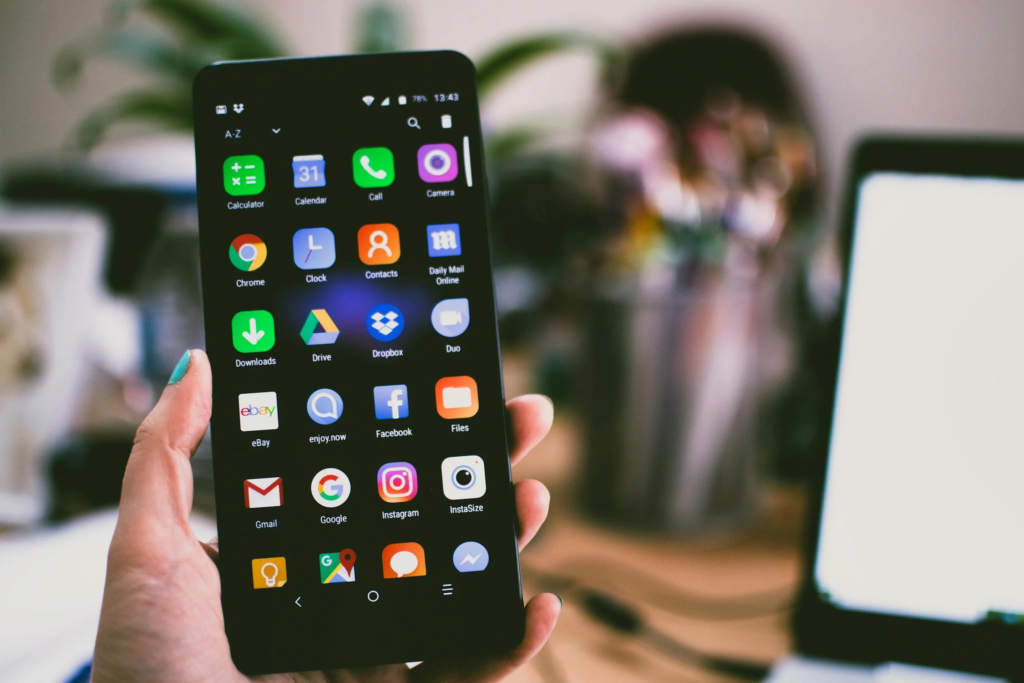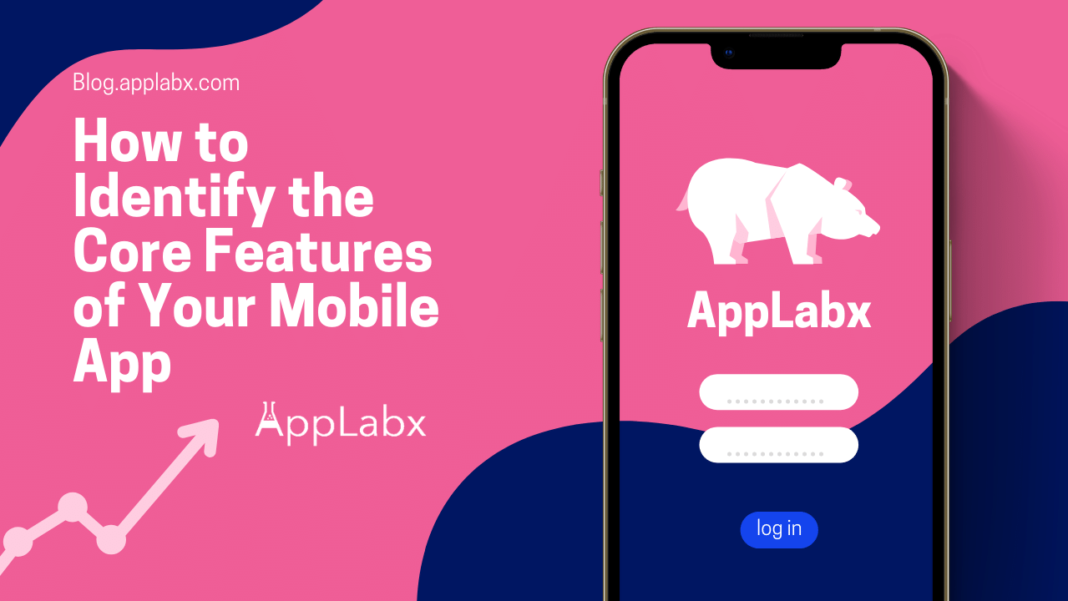Key Takeaways
- Audience Insights Drive Success: Understand your target users’ needs and preferences through thorough research to pinpoint essential features.
- Prioritize Impactful Functionality: Focus on must-have features that align with your app’s purpose and deliver maximum value to users.
- Iterate for Excellence: Embrace iterative development and testing to refine features based on user feedback, ensuring continuous improvement and app success.
In the ever-evolving landscape of mobile applications, the difference between success and obscurity often lies in the strategic selection of core features.
Crafting a mobile app that captivates users, fulfills their needs, and stands out in a crowded marketplace requires meticulous planning and foresight.
In this comprehensive guide, we delve deep into the crucial process of identifying the core features of your mobile app, offering invaluable insights, actionable strategies, and expert advice to steer you towards success.

In today’s hyperconnected world, where smartphones have become an extension of our daily lives, the demand for innovative and user-centric mobile applications continues to soar.
However, with millions of apps vying for attention across various app stores, the journey from conception to prominence is fraught with challenges.
While a groundbreaking idea may serve as the cornerstone of your app’s potential success, it is the execution and strategic feature selection that ultimately determine its fate.
Understanding the intricacies of your target audience forms the bedrock of effective feature identification.
By delving into the demographics, preferences, and behavior patterns of your prospective users, you gain invaluable insights that inform your feature selection process.
Whether you’re targeting tech-savvy millennials or professionals seeking productivity tools, aligning your app’s features with the needs and desires of your audience is paramount.
Moreover, defining the overarching purpose and goals of your mobile app is essential for steering your development efforts in the right direction.
Are you aiming to streamline everyday tasks, provide entertainment, or revolutionize an industry?
By articulating clear objectives and setting SMART (Specific, Measurable, Achievable, Relevant, Time-bound) goals, you create a roadmap that guides feature prioritization and development, ensuring alignment with your business objectives.
Prioritizing features is another critical aspect of the feature identification process. Not all features are created equal, and distinguishing between must-have functionalities and nice-to-have enhancements is pivotal for resource allocation and user satisfaction.
Through methodologies such as MoSCoW (Must have, Should have, Could have, Won’t have) or Kano model analysis, you can systematically evaluate features based on their importance, feasibility, and potential impact on user experience.
Furthermore, conducting thorough competitor analysis provides valuable insights into prevailing market trends, user expectations, and competitive landscapes.
By scrutinizing rival apps and identifying common features, differentiators, and pain points, you gain a nuanced understanding of what works and what doesn’t in your niche.
Leveraging these insights enables you to refine your feature set, identify unique selling propositions, and carve out a distinctive position in the market.
User experience (UX) and interface design play a pivotal role in shaping the success of your mobile app.
Seamless navigation, intuitive user flows, and aesthetically pleasing interfaces enhance user engagement and retention, fostering long-term loyalty and advocacy.
By incorporating user feedback and conducting usability testing throughout the development cycle, you can iteratively refine your app’s features, ensuring they resonate with your target audience and deliver unparalleled user experiences.
In the dynamic realm of mobile app development, embracing an agile mindset is indispensable.
Iterative development and testing allow you to adapt to evolving user needs, market dynamics, and technological advancements.
By embracing feedback-driven iteration, you can refine your app’s features, address pain points, and stay ahead of the competition, ensuring sustained relevance and success in the ever-changing mobile landscape.
In conclusion, the process of identifying the core features of your mobile app is a multifaceted journey that requires careful planning, user-centricity, and adaptability.
By understanding your audience, defining clear objectives, prioritizing features, analyzing competitors, and prioritizing user experience, you can create a mobile app that resonates with users, fulfills their needs, and achieves enduring success in the competitive app ecosystem.
Join us as we embark on this enlightening exploration, empowering you to unlock the full potential of your mobile app endeavors.
Before we venture further, we like to share who we are and our digital experiences.
About AppLabx
From developing a solid marketing plan to creating compelling content, optimizing for search engines, leveraging social media, and utilizing paid advertising, AppLabx offers a comprehensive suite of digital marketing services designed to drive growth and profitability for your business.
AppLabx is well known for helping companies and startups use Mobile ASO to drive traffic to their websites and web apps.
At AppLabx, we understand that no two businesses are alike. That’s why we take a personalized approach to every project, working closely with our clients to understand their unique needs and goals, and developing customized strategies to help them achieve success.
If you need a digital consultation, then send in an inquiry here.
How to Identify the Core Features of Your Mobile App
- Understanding Your Audience
- Defining the Purpose and Goals of Your App
- Prioritizing Features
- Conducting Competitor Analysis
- User Experience and Interface Design
- Iterative Development and Testing
1. Understanding Your Audience
In the dynamic world of mobile app development, success hinges on your ability to deeply understand and cater to the needs, preferences, and behaviors of your target audience.
By conducting thorough research and analysis, you can gain invaluable insights that inform your feature selection process and pave the way for a user-centric app experience.

Defining Your Target Audience Demographics
- Demographic Segmentation: Start by segmenting your audience based on demographic factors such as age, gender, location, income level, and occupation.
- Example: If you’re developing a fitness tracking app, your primary demographic may include health-conscious individuals aged 18-35, predominantly located in urban areas, with disposable income for fitness-related expenses.
- Psychographic Profiling: Dive deeper into your audience’s psychographic characteristics, including their lifestyles, interests, values, and aspirations.
- Example: For a meditation and mindfulness app, your audience may comprise busy professionals seeking stress relief, working parents juggling multiple responsibilities, and students striving for academic success.
- Behavioral Analysis: Analyze user behavior patterns such as app usage frequency, duration, and in-app interactions to glean insights into their preferences and engagement habits.
- Example: An e-commerce app may observe that a significant portion of its users regularly browse products but abandon their carts before completing purchases, indicating a need to optimize the checkout process and reduce friction points.
Conducting Market Research
- Competitor Analysis: Identify and analyze direct and indirect competitors within your app’s niche to understand prevailing market trends, feature offerings, and competitive landscapes.
- Example: If you’re developing a meal delivery app, analyze competitors like Uber Eats, DoorDash, and Grubhub to assess their strengths, weaknesses, and unique selling propositions.
- SWOT Analysis: Conduct a SWOT (Strengths, Weaknesses, Opportunities, Threats) analysis to evaluate your app’s market positioning, competitive advantages, and areas for improvement.
- Example: A social networking app may identify its strengths in fostering meaningful connections, weaknesses in data privacy concerns, opportunities in niche community building, and threats from established platforms like Facebook.
Utilizing User Personas
- Persona Creation: Develop detailed user personas representing archetypal members of your target audience, complete with fictional names, backgrounds, motivations, and pain points.
- Example: Create personas such as “Active Annie,” a fitness enthusiast who prioritizes workouts and meal planning, or “Busy Brian,” a working professional seeking quick and convenient meal solutions.
- Empathy Mapping: Use empathy mapping techniques to step into the shoes of your personas, empathize with their needs and challenges, and envision how your app can address their pain points.
- Example: Visualize “Stressed Sarah’s” daily routine, empathize with her struggles to find moments of calm amidst a hectic schedule, and brainstorm features like guided meditations and relaxation exercises tailored to her needs.
- Scenario Mapping: Map out user scenarios and journey maps to understand the various touchpoints and interactions users have with your app throughout their customer journey.
- Example: Outline “Fitness Fred’s” journey from discovering the app through social media ads to signing up, setting fitness goals, tracking workouts, and celebrating milestones, highlighting key touchpoints for feature integration and optimization.
By meticulously dissecting your audience’s demographics, conducting comprehensive market research, and crafting detailed user personas, you lay the groundwork for a mobile app that resonates with your target audience, fulfills their needs, and surpasses their expectations.
2. Defining the Purpose and Goals of Your App
Before embarking on the journey of mobile app development, it’s imperative to articulate a clear purpose and set SMART (Specific, Measurable, Achievable, Relevant, Time-bound) goals that align with your overarching objectives.
By defining your app’s purpose and goals upfront, you lay the foundation for strategic feature selection and development that drives tangible results and fosters user engagement and satisfaction.

Establishing the Primary Objective
- Identify Core Functionality: Determine the primary function or value proposition that your app aims to deliver to users.
- Example: A language learning app may aim to help users acquire new language skills through interactive lessons, quizzes, and immersive experiences.
- Addressing User Needs: Understand the pain points, challenges, and aspirations of your target audience and position your app as a solution to their problems.
- Example: A budgeting app may address the need for financial management and planning among users by offering features such as expense tracking, budgeting tools, and personalized insights.
- Fulfilling Market Gaps: Identify gaps or underserved segments within your target market and tailor your app’s purpose to address these unmet needs.
- Example: A meal planning app may cater to users who seek convenient, healthy meal solutions by providing personalized recipes, meal suggestions, and grocery lists.
Setting SMART Goals
- Specific Objectives: Define precise, concrete goals that outline what you aim to achieve with your app.
- Example: Increase user engagement by 20% within the first three months of app launch through gamification features and social sharing capabilities.
- Measurable Metrics: Establish key performance indicators (KPIs) and metrics to track the progress and success of your app over time.
- Example: Track metrics such as daily active users (DAU), retention rate, in-app purchases, and average session duration to gauge user engagement and monetization potential.
- Achievable Targets: Set goals that are realistic and attainable within the constraints of your resources, timeline, and market dynamics.
- Example: Achieve a four-star rating or higher on app stores within six months of launch by actively soliciting user feedback and implementing iterative improvements.
- Relevant Alignment: Ensure that your goals are aligned with your app’s purpose, target audience, and overarching business objectives.
- Example: Increase brand visibility and recognition by securing coverage in top-tier tech publications and influencers’ social media channels within the first year of app launch.
- Time-bound Deadlines: Establish clear deadlines and milestones to create a sense of urgency and accountability in achieving your goals.
- Example: Launch a major app update with enhanced features and performance optimizations by the end of the quarter to coincide with a targeted marketing campaign and seasonal trends.
Aligning Features with Business Objectives
- Revenue Generation: Determine how your app will generate revenue, whether through app purchases, subscription fees, in-app purchases, or advertising.
- Example: A productivity app may offer a freemium model with basic features available for free and premium features unlocked through a subscription-based model.
- User Acquisition and Retention: Design features that attract new users, encourage user retention, and foster long-term engagement and loyalty.
- Example: A social networking app may incorporate viral features such as friend invites, user-generated content sharing, and personalized notifications to drive user growth and retention.
- Brand Building and Differentiation: Leverage your app as a branding tool to enhance brand visibility, differentiation, and customer loyalty.
- Example: Incorporate branded elements such as logos, colors, and messaging that align with your brand identity and resonate with your target audience.
By defining a clear purpose, setting SMART goals, and aligning features with your app’s business objectives, you create a strategic roadmap for development that maximizes user value, drives growth, and positions your app for long-term success in the competitive mobile landscape.
3. Prioritizing Features
Prioritizing features is a critical step in the mobile app development process, ensuring that limited resources are allocated to the most impactful functionalities that align with user needs and business objectives.
By adopting systematic methodologies and considering various factors, you can optimize feature prioritization to maximize user satisfaction, engagement, and app success.

Identifying Must-have Features vs. Nice-to-have Features
- Essential Functionality: Identify core features that are indispensable for fulfilling the primary purpose and value proposition of your app.
- Example: A ride-sharing app must include features such as user registration, driver matching, real-time tracking, and payment processing to facilitate seamless ride bookings and fulfill user expectations.
- Enhancement Features: Distinguish between additional features that enhance user experience but are not essential for the app’s core functionality.
- Example: A social media app may offer optional features such as photo filters, stickers, and augmented reality (AR) effects to enrich user interactions and expressiveness without compromising the app’s fundamental usability.
Conducting Feature Prioritization Exercises
- MoSCoW Analysis: Categorize features into four priority levels: Must have, Should have, Could have, and Won’t have, based on their criticality and impact on user experience.
- Example: Prioritize features such as user authentication, messaging functionality, and profile management as “Must have” to ensure basic app functionality and user engagement.
- Kano Model Analysis: Evaluate features based on their potential to delight users, meet basic expectations, or cause dissatisfaction, enabling prioritization based on perceived user value.
- Example: Identify features that serve as “exciters” or “delighters,” such as personalized recommendations or exclusive rewards, to differentiate your app and exceed user expectations.
Considering Factors for Prioritization
- Feasibility and Resources: Assess the technical complexity, development effort, and resource requirements associated with implementing each feature.
- Example: Prioritize features that align with your development team’s expertise, available resources, and time constraints to ensure timely delivery without compromising quality.
- Impact on User Experience: Evaluate the potential impact of each feature on enhancing usability, engagement, and satisfaction for your target audience.
- Example: Prioritize features that streamline user workflows, reduce friction points, and deliver tangible benefits, such as time savings or increased productivity.
- Competitive Differentiation: Consider how each feature contributes to your app’s unique value proposition and competitive advantage in the market.
- Example: Prioritize features that differentiate your app from competitors, address unmet user needs, or capitalize on emerging trends to carve out a distinct market position and attract users.
Iterative Refinement and Adaptation
- Feedback-driven Iteration: Gather user feedback through alpha and beta testing, user surveys, and analytics to iteratively refine and prioritize features based on real-world usage and user preferences.
- Example: Incorporate user feedback on feature usability, performance, and relevance to prioritize iterative improvements and optimizations that enhance overall app satisfaction.
- Agile Development Practices: Embrace agile methodologies such as Scrum or Kanban to continuously prioritize and adapt features based on changing market dynamics, user feedback, and business priorities.
- Example: Conduct regular sprint planning sessions to reevaluate feature priorities, reprioritize backlog items, and adjust development efforts based on evolving requirements and stakeholder feedback.
Summary
Prioritizing features is a strategic process that requires careful consideration of user needs, business objectives, and resource constraints.
By adopting systematic methodologies, evaluating key factors, and embracing iterative refinement, you can optimize feature prioritization to create a mobile app that resonates with users, drives engagement, and achieves sustainable success in the competitive app market.
4. Conducting Competitor Analysis
In the fiercely competitive landscape of mobile app development, conducting thorough competitor analysis is essential for gaining insights into market trends, user preferences, and competitive strategies.

By dissecting rival apps and benchmarking against industry peers, you can identify opportunities, mitigate risks, and refine your own app’s features and positioning for success.
Identifying Direct and Indirect Competitors
- Direct Competitors: Identify apps that offer similar functionalities, target the same audience, and compete directly with your app in the marketplace.
- Example: For a photo editing app, direct competitors may include Adobe Photoshop Express, Snapseed, and VSCO, which offer similar editing tools and features.
- Indirect Competitors: Identify apps that address similar user needs or compete for users’ time and attention, even if they operate in different industries or verticals.
- Example: A meditation and mindfulness app may consider fitness apps like Nike Training Club and Headspace as indirect competitors, as they offer alternative ways for users to manage stress and improve well-being.
Analyzing Competitor Apps
- Feature Comparison: Evaluate the features, functionalities, and user experience offered by competitor apps to identify commonalities, differentiators, and areas for improvement.
- Example: Compare user interfaces, editing tools, filter options, and social sharing capabilities across photo editing apps to assess feature parity and innovation.
- User Reviews and Ratings: Scrutinize user reviews and ratings on app stores and review websites to understand user feedback, pain points, and satisfaction levels with competitor apps.
- Example: Analyze common themes and sentiments expressed in user reviews of fitness apps to identify recurring issues, feature requests, and areas where competitors excel or fall short.
Leveraging Competitive Insights
- Strengths and Weaknesses: Identify competitor strengths, weaknesses, opportunities, and threats (SWOT) to inform your own app development strategy and feature prioritization.
- Example: Recognize competitors’ strengths in user engagement features, such as challenges, leaderboards, and social sharing, and leverage these insights to enhance your app’s gamification elements.
- Unique Selling Proposition (USP): Determine what sets your app apart from competitors and highlight your unique value proposition to attract users and differentiate your offering.
- Example: Emphasize your app’s intuitive user interface, advanced editing algorithms, or exclusive partnerships with renowned photographers as key selling points that distinguish it from rival photo editing apps.
Benchmarking Performance Metrics
- App Store Rankings: Monitor competitors’ rankings on app stores and track changes over time to gauge their visibility, popularity, and user adoption.
- Example: Compare competitors’ app store rankings in relevant categories, such as “Health & Fitness” or “Photo & Video,” to assess their market share and competitive positioning.
- Download and Usage Metrics: Analyze competitors’ download counts, user acquisition channels, and app usage metrics to understand their growth trajectory and user engagement levels.
- Example: Track competitors’ download trends, monthly active users (MAU), and average session durations to benchmark against your own app’s performance and identify areas for improvement.
Summary
Conducting competitor analysis is a strategic imperative for mobile app developers seeking to gain a competitive edge and maximize their app’s success in the marketplace.
By meticulously dissecting rival apps, benchmarking performance metrics, and leveraging competitive insights, you can identify opportunities, mitigate risks, and refine your app’s features and positioning to meet user needs and surpass competitors.
Armed with a deep understanding of the competitive landscape, you’re better equipped to make informed decisions and propel your app towards sustained growth and profitability.
5. User Experience and Interface Design
Creating an intuitive and visually appealing user experience (UX) is crucial for the success of your mobile app.
From seamless navigation to engaging interactions, every aspect of your app’s interface design plays a pivotal role in shaping user perceptions and driving engagement. Here’s a comprehensive guide to mastering UX and interface design for your mobile app:
Understanding User Needs and Behaviors
- User Research: Conduct thorough user research to understand your target audience’s needs, preferences, and pain points.
- Example: A travel app may conduct surveys and interviews to uncover travelers’ preferences for booking flights, accommodations, and activities.
- User Personas: Develop user personas representing different segments of your target audience to guide design decisions.
- Example: A fitness app may create personas such as “Busy Professional” and “Fitness Enthusiast” to tailor features and content to specific user needs.
Creating Intuitive Navigation
- Clear Information Architecture: Organize content and features in a logical hierarchy to facilitate intuitive navigation.
- Example: A shopping app may categorize products into distinct sections such as “Clothing,” “Electronics,” and “Home Decor” for easy browsing.
- Streamlined User Flows: Design seamless user flows that guide users through tasks and interactions with minimal friction.
- Example: A banking app may create a straightforward user flow for transferring funds, from selecting the recipient to confirming the transaction.
Designing Engaging Interactions
- Interactive Elements: Incorporate interactive elements such as buttons, sliders, and gestures to enhance user engagement.
- Example: A gaming app may include swipe gestures for navigating menus and tapping animations for in-game actions.
- Microinteractions: Add subtle animations and feedback cues to delight users and provide visual feedback for their actions.
- Example: A messaging app may display typing indicators and message sent animations to indicate real-time communication.
Prioritizing Accessibility and Inclusivity
- Accessible Design: Ensure your app is accessible to users with disabilities by adhering to accessibility guidelines and standards.
- Example: Provide alternative text for images, enable screen reader support, and offer adjustable font sizes for visually impaired users.
- Inclusive Design: Design with diversity in mind, considering users with varying cultural backgrounds, languages, and technological literacy levels.
- Example: A language learning app may offer multilingual support and culturally relevant content to cater to a global audience.
Balancing Aesthetics and Functionality
- Visual Design: Create visually appealing interfaces with cohesive color schemes, typography, and imagery.
- Example: A photography app may use a minimalist design with high-resolution images and elegant typography to showcase user photos effectively.
- Brand Consistency: Maintain consistency with your brand identity across all design elements to reinforce brand recognition and trust.
- Example: A food delivery app may use consistent brand colors, logo placement, and tone of voice in its app interface and marketing materials.
Iterative Testing and Optimization
- Usability Testing: Conduct usability testing sessions with real users to identify usability issues and gather feedback for iterative improvements.
- Example: A productivity app may observe users completing tasks like creating to-do lists and scheduling events to uncover usability issues and pain points.
- A/B Testing: Experiment with different design variations and features through A/B testing to determine the most effective design choices.
- Example: An e-commerce app may test different button colors and placements to determine which variation leads to higher conversion rates.
Summary
User experience and interface design are integral aspects of mobile app development that can make or break the success of your app.
By understanding user needs, creating intuitive navigation, designing engaging interactions, prioritizing accessibility, balancing aesthetics and functionality, and iteratively testing and optimizing your design, you can create a mobile app that delights users, drives engagement, and achieves lasting success in the competitive app market.
6. Iterative Development and Testing
Iterative development and testing are integral components of the mobile app development process, enabling continuous refinement, optimization, and validation of app features to meet user needs and quality standards.
By embracing an agile mindset and incorporating feedback-driven iteration, developers can enhance app performance, usability, and user satisfaction throughout the development lifecycle.

Adopting an Agile Development Approach
- Agile Methodologies: Embrace agile frameworks such as Scrum, Kanban, or Lean to promote collaboration, flexibility, and adaptability in app development.
- Example: Implement Scrum sprints to break down development tasks into manageable increments, conduct regular sprint planning, review meetings, and retrospectives to foster transparency and accountability.
- Cross-functional Teams: Form interdisciplinary teams comprising developers, designers, testers, and stakeholders to promote collaboration, communication, and collective ownership of project goals.
- Example: Create cross-functional teams with expertise in frontend development, backend architecture, UI/UX design, quality assurance (QA), and product management to ensure comprehensive coverage of app development activities.
Conducting Usability Testing and User Feedback
- Alpha and Beta Testing: Engage in alpha and beta testing phases to gather feedback from internal stakeholders and external users, respectively, and identify usability issues, bugs, and opportunities for improvement.
- Example: Invite a select group of alpha testers, such as employees or trusted partners, to evaluate early app prototypes and provide feedback on functionality, usability, and performance.
- User Surveys and Feedback Loops: Solicit user feedback through surveys, feedback forms, in-app prompts, and customer support channels to collect insights, preferences, and pain points that inform iterative development.
- Example: Deploy in-app surveys or feedback forms to capture user sentiment, feature requests, and satisfaction levels, and leverage analytics tools to analyze user interactions and behavior patterns.
Iteratively Refining Features and Functionality
- Feature Prioritization: Continuously reassess and reprioritize app features based on user feedback, market trends, and business objectives to focus development efforts on high-impact functionalities.
- Example: Iterate on feature prioritization based on feedback from usability testing sessions, adjusting backlog items and sprint goals to address critical user needs and pain points.
- Incremental Enhancements: Implement iterative improvements and optimizations to existing features based on user feedback, performance metrics, and usability testing results.
- Example: Release regular app updates with bug fixes, performance optimizations, and feature enhancements based on user feedback and evolving market trends to maintain app relevance and user satisfaction.
Continuous Integration and Deployment (CI/CD)
- Automated Testing: Integrate automated testing frameworks and continuous integration pipelines to streamline testing processes, detect regressions, and ensure code quality throughout the development lifecycle.
- Example: Implement unit tests, integration tests, and end-to-end (E2E) tests using frameworks like XCTest, Espresso, or Appium to automate test execution and validate app functionality across various devices and platforms.
- Continuous Deployment: Automate app deployment and release processes to facilitate rapid iteration, minimize time-to-market, and deliver new features and updates to users seamlessly.
- Example: Adopt continuous deployment pipelines with tools like Jenkins, CircleCI, or GitHub Actions to automate build, test, and deployment workflows, enabling frequent releases and real-time feedback loops with users.
Summary
Iterative development and testing are fundamental pillars of successful mobile app development, enabling teams to iterate on features, gather user feedback, and deliver high-quality apps that meet user needs and expectations.
By adopting agile methodologies, conducting usability testing, iteratively refining features, and embracing continuous integration and deployment practices, developers can accelerate innovation, mitigate risks, and ensure the long-term success of their apps in the competitive app market.
Conclusion
The process of identifying the core features of your mobile app is a multifaceted journey that demands meticulous planning, strategic foresight, and a deep understanding of your target audience and business objectives.
By following the comprehensive steps outlined in this guide, you can navigate the complexities of feature identification with clarity, confidence, and purpose, setting the stage for the development of a successful and user-centric mobile app.
From understanding your audience and defining clear objectives to prioritizing features, conducting competitor analysis, and embracing iterative development and testing, each stage of the process plays a pivotal role in shaping the trajectory of your app’s success.
By leveraging market insights, user feedback, and industry best practices, you can refine your app’s feature set to deliver maximum value, engagement, and satisfaction to your target audience.
Moreover, the journey of feature identification is not a one-time endeavor but rather an ongoing process of iteration, adaptation, and optimization.
As user needs evolve, market dynamics shift, and technological advancements emerge, it’s essential to remain agile and responsive, continuously refining your app’s features to stay ahead of the curve and deliver exceptional user experiences.
In today’s competitive app market, where millions of apps vie for users’ attention and loyalty, the ability to identify and prioritize core features effectively can mean the difference between success and obscurity.
By investing time and effort into understanding your audience, aligning features with business objectives, and iterating based on user feedback and market insights, you can create a mobile app that not only meets but exceeds user expectations, driving engagement, retention, and ultimately, business growth.
In essence, the journey of identifying the core features of your mobile app is a strategic imperative that requires diligence, creativity, and a relentless commitment to delivering value to your users.
Armed with the insights and strategies outlined in this guide, you’re well-equipped to embark on this enlightening journey and unlock the full potential of your mobile app endeavors. So, seize the opportunity, embrace the challenge, and let your app shine in the ever-evolving world of mobile innovation.
If you are looking for a top-class digital marketer, then book a free consultation slot here.
If you find this article useful, why not share it with your friends and business partners, and also leave a nice comment below?
We, at the AppLabx Research Team, strive to bring the latest and most meaningful data, guides, and statistics to your doorstep.
To get access to top-quality guides, click over to the AppLabx Blog.
People also ask
What is the importance of identifying core features for a mobile app?
Identifying core features ensures your app meets user needs effectively, drives engagement, and differentiates it from competitors.
How can I understand my app’s target audience?
Conduct thorough audience research, analyze demographics, psychographics, and behaviors to gain insights into user preferences.
What are some common methods for prioritizing app features?
Methods like MoSCoW analysis, Kano model, and user story mapping help prioritize features based on importance and user impact.
How do I differentiate between must-have and nice-to-have features?
Must-have features are essential for your app’s functionality and user satisfaction, while nice-to-have features are optional enhancements.
What role does competitor analysis play in identifying core features?
Competitor analysis helps identify market trends, user expectations, and competitive gaps, informing feature selection and differentiation.
How can user personas help in feature identification?
User personas represent typical users and their needs, guiding feature selection based on user behaviors, goals, and pain points.
What are SMART goals, and why are they important in feature identification?
SMART goals are Specific, Measurable, Achievable, Relevant, and Time-bound objectives that guide feature selection and development efforts.
How can I align app features with business objectives?
Align features with business goals such as revenue generation, user acquisition, and brand building to ensure strategic alignment and success.
What is the significance of iterative development in feature identification?
Iterative development allows for continuous refinement of features based on user feedback, market changes, and evolving business needs.
How can usability testing contribute to feature identification?
Usability testing helps uncover user experience issues, validate feature usability, and inform iterative improvements to enhance app functionality.
How do I gather user feedback for feature identification?
Collect user feedback through surveys, feedback forms, in-app prompts, and customer support channels to understand user preferences and pain points.
What are some common challenges in identifying core features?
Common challenges include balancing user needs with technical constraints, prioritizing features effectively, and staying ahead of market trends.
What role does user engagement play in feature identification?
User engagement metrics such as retention rate, session duration, and in-app actions help gauge feature effectiveness and inform iterative improvements.
How can I adapt my app’s features to changing user needs?
Stay agile and responsive to user feedback, market trends, and technological advancements, iterating on features to meet evolving user needs.
How can I ensure the scalability of my app’s core features?
Design features with scalability in mind, using modular architecture and scalable infrastructure to accommodate future growth and demand.
What strategies can I use to validate the effectiveness of core features?
Conduct A/B testing, measure key performance indicators (KPIs), and track user analytics to validate feature effectiveness and iterate accordingly.
How do I ensure the security and privacy of core app features?
Implement robust security measures such as encryption, authentication, and data protection protocols to safeguard user data and ensure privacy compliance.
What are some best practices for maintaining and updating core app features?
Regularly monitor app performance, gather user feedback, and prioritize feature updates based on user needs, market trends, and business objectives.
How can I optimize app performance while maintaining core features?
Optimize codebase, minimize app size, and leverage caching and prefetching techniques to enhance app performance without compromising core features.
What strategies can I use to monetize core app features?
Explore monetization models such as freemium, subscription, in-app purchases, and advertising to generate revenue from core app features.
How do I ensure cross-platform compatibility for core app features?
Adopt cross-platform development frameworks, follow platform-specific guidelines, and conduct thorough testing to ensure seamless functionality across devices and platforms.
How can I future-proof core app features against technological advancements?
Stay informed about emerging technologies and industry trends, design features with flexibility and scalability, and plan for future updates and integrations.
What metrics should I track to measure the success of core app features?
Track metrics such as user engagement, retention rate, conversion rate, and customer lifetime value to measure feature effectiveness and overall app success.
How do I prioritize bug fixes and feature updates for core app features?
Prioritize bug fixes based on severity and impact on user experience, and prioritize feature updates based on user feedback, market trends, and business objectives.
What are some common pitfalls to avoid in feature identification?
Avoid feature bloat, overcomplicating user interfaces, neglecting user feedback, and failing to adapt to changing market dynamics.
How can I foster innovation in core app features?
Encourage creativity and collaboration within your development team, solicit feedback from users and stakeholders, and embrace experimentation and iteration in feature development.
What resources are available to assist with feature identification and development?
Utilize online forums, developer communities, documentation, and industry publications to stay informed about best practices, tools, and resources for feature identification and development.






























